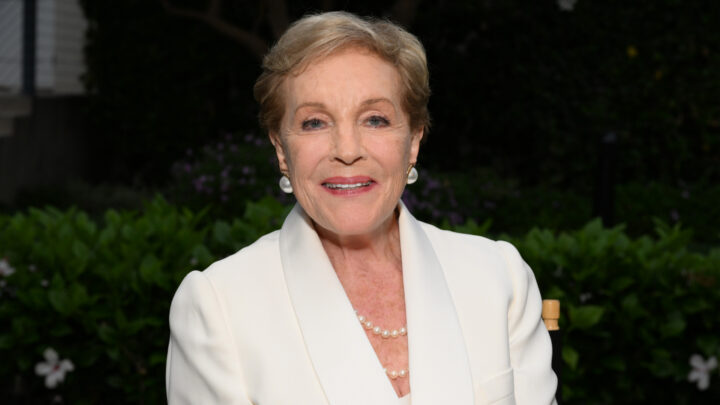Julie Andrews: Behind the Perfect Smile – Her Secret Struggles and Inspiring Journey
Julie Andrews is universally celebrated for her iconic roles as Mary Poppins and Maria von Trapp, epitomizing charm, elegance, and timeless talent. But behind her famous smile lies a heartbreaking secret that she concealed for decades.
Now, at 89, Andrews has bravely opened up about the devastating loss of her legendary singing voice, the truth behind her marriage to Blake Edwards, and the regrets she’s carried for years.
Born Julia Elizabeth Wells on October 1, 1935, in Surrey, England, Andrews’ path to stardom was anything but simple. Her mother, Barbara Ward Morris, a pianist with stage dreams, and her stepfather, Ted Andrews, introduced her early to music and performance.
At age 14, Andrews discovered that Edward Wells was not her biological father, a revelation that, while shocking, did not diminish their bond.
Andrews’ vocal talents emerged early. Under the rigorous training of Madame Lillian Styles Allen, she developed perfect pitch and a stunning vocal range.
By age 12, she dazzled audiences at London’s Hippodrome, becoming Britain’s youngest primadonna. Her Royal Command performance for King George VI at just 13 solidified her early fame.

Broadway quickly recognized her extraordinary talent. At 19, Andrews debuted in “The Boyfriend” (1954), receiving critical acclaim and setting the stage for her legendary portrayal of Eliza Doolittle in “My Fair Lady” (1956).
Although famously overlooked for the film adaptation in favor of Audrey Hepburn, Andrews rebounded spectacularly with Disney’s “Mary Poppins” (1964), earning an Oscar for Best Actress, triumphantly overshadowing Hollywood’s previous snub.
The massive success of “The Sound of Music” (1965), one of the highest-grossing films ever, cemented Andrews as Hollywood royalty. However, her unparalleled success also trapped her in a wholesome, nanny image, prompting Andrews to break from typecasting with dramatic roles like “The Americanization of Emily” and Hitchcock’s “Torn Curtain.”
Yet, Hollywood’s fickle nature soon showed itself. High-profile failures like “Star!” (1968) and “Darling Lili” (1970)—directed by her husband Blake Edwards—signaled a troubling downturn.
Despite critical acclaim, box office disappointments pushed Andrews away from cinema, forcing her to reinvent herself through television and nightclub performances.
The “Julie Andrews Hour” (1972) was critically adored but short-lived, despite a dominant Emmy performance. Andrews responded by entering the nightclub scene, surprising audiences accustomed to her pristine image.

Her edgy, sophisticated nightclub act revitalized her career, setting the stage for her cinematic comeback in Blake Edwards’ “10” (1979), a box office hit.
Andrews continued challenging her image with bold films like “S.O.B.” (1981)—where she shockingly appeared topless—and “Victor/Victoria” (1982), a groundbreaking role exploring gender identity that earned her a Golden Globe and an Academy Award nomination. Her fearless reinvention demonstrated her extraordinary range and enduring appeal.
Her personal life was equally dramatic. Married first to Tony Walton, with whom she shared daughter Emma, Andrews faced heartbreak when her marriage ended amidst career pressures.
Her subsequent marriage to Blake Edwards was enduring, marked by mutual creative collaboration and personal resilience. They adopted two daughters from Vietnam, and their 41-year marriage, ending with Edwards’ death in 2010, was described by Andrews as a true love story.
But perhaps the greatest tragedy in Andrews’ life came in 1997. During the Broadway run of “Victor/Victoria,” she developed severe vocal strain, prompting surgery at Mount Sinai Hospital.
Intended as routine, the surgery tragically destroyed her singing voice due to severe scarring on her vocal cords. The legendary soprano voice, responsible for so many iconic performances, was permanently silenced.

The loss profoundly impacted Andrews. She sued the hospital for malpractice, settling privately in 2000. Although additional procedures improved her speaking voice slightly, her singing voice never returned.
Rather than withdrawing, Andrews courageously embraced new directions, advocating for vocal cord research, co-authoring children’s books with her daughter, and continuing to perform in film and television, albeit without her iconic singing.
In 2001, Andrews returned to Disney, delighting audiences as Queen Clarice in “The Princess Diaries,” a role that introduced her timeless charm to new generations.
She further lent her iconic voice to Queen Lillian in the “Shrek” franchise, and directed a celebrated stage production of “My Fair Lady” in 2016.
Now openly discussing her experiences, Andrews has candidly shared the lingering heartbreak of losing her singing voice. Her reflections reveal not just regret but profound resilience.
She remains beloved worldwide, her contributions to entertainment cemented in history. Julie Andrews’ legacy is one of talent, courage, and an indomitable spirit—a star whose brilliance transcends even her darkest struggles.


